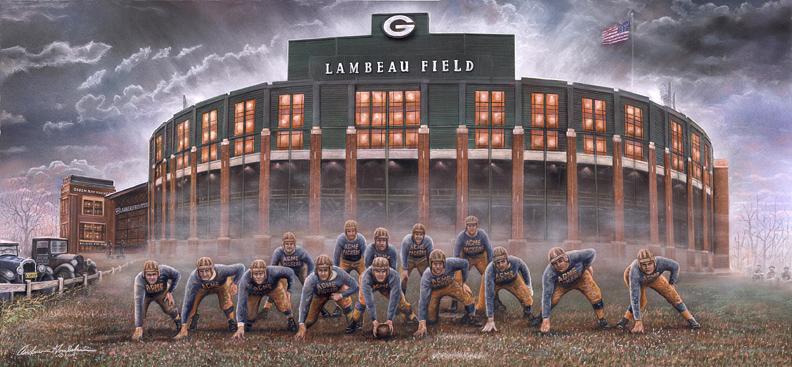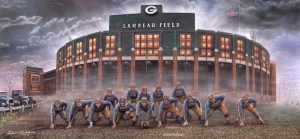Understanding the Corporate Structure of the Green Bay Packers

As a native Minnesotan, I am a lifelong Minnesota Vikings fan. However, I have what you’d call a “mixed marriage”, and I don’t mean mixed in religious or political beliefs; no, I mean in football loyalties; you see, I married a Green Bay Packers fan.
My wife, however, just isn’t any Packers fan. She was born in Green Bay, Wisconsin, and like any person who has lived in or around Green Bay, she has countless stories about seeing various Packer players and coaches around town and doing such ordinary things such as filling up their cars at the gas station or grocery shopping at the local supermarket. People who were heroes to others are neighbors to folks from Green Bay. Lambeau Field, the Packers’ home stadium, is viewed as a community asset, and after a large snowfall during the football season, Green Bay residents volunteer, shovels in hand, to clear out the seats.
Having visited Lambeau Field, the Packer Hall of Fame and countless other team landmarks, even as an ardent fan of the rival Vikings, you cannot help but appreciate and respect the legacy of the team from the NFL’s smallest city. In fact, I’ll admit to being the proud owner of a Bart Starr #15 throwback jersey, a Vince Lombardi “GB” baseball cap, Brett Favre jerseys (Packers and Vikings varieties) and countless other items of Cheesehead garb. With the Vikings’ ongoing stadium issues, I’ve joked that all my Packer gear is simply preparation for when the Vikings depart for Los Angeles (and I’m only half joking when I say that).
The Green Bay Packers’ improbable run to a fourth Super Bowl championship has reminded the sporting public about this unique team and its seemingly never-ending mystique. As impressive as the Packers’ on the field history has been (thirteen league championships, more than any other team in the National Football League, including four Super Bowl championships in the 1966, 1967, 1996 and 2010 seasons), the team’s corporate structure is perhaps the key to the team’s place in sports history and American culture.
The Packers are the last vestige of “small town teams” that were once common in the NFL during the 1920s and 1930s (for example, Duluth, Minnesota was home to two NFL teams in the 1920s – the Kelley Duluths from 1923-25 and the Duluth Eskimos from 1926-27). Founded in 1919 by Earl “Curly” Lambeau (thus the name Lambeau Field in which the team presently plays) and George Whitney Calhoun, the Green Bay Packers can trace their lineage to other semi-professional teams in Green Bay dating back to 1896.
Non-Profit Wisconsin Corporation; Board of Directors
The Packers represent – from an organizational standpoint – the only publicly owned franchise in the 32-team NFL. In fact, the Packers are now the only publicly owned company with a board of directors in American professional sports (although other teams are directly owned by publicly traded companies, such as the New York Rangers (Cablevision), the Seattle Mariners (Nintendo of America), and the Toronto Blue Jays (Rogers Communications)). Instead of the team being owned by one person, partnership, or corporate entity; thus, a “team owner”, the Board of Directors (“Board”) of Green Bay Packers, Inc., a Wisconsin corporation (the “Corporation”), is the organization that serves as the “owner” for the Green Bay Packers football club. It has been speculated that this is one of the reasons the Green Bay Packers have never been moved from the city of Green Bay, a city of only 102,313 people as of the 2000 census.
Executive Committee
The Corporation is governed by a seven-member Executive Committee, elected from a Board. The Executive Committee directs corporate management, approves major capital expenditures, establishes broad policy and monitors management’s performance in conducting the business and affairs of the Corporation. The President is the only officer who receives compensation. The balance of the Executive Committee is sitting gratis.
Shareholders
The Corporation currently has 111,921 stockholders, who collectively own 4,749,925 shares of stock. There have been four (4) stock sales, in 1923, 1935, 1950 and 1997. Shares in 1923 sold for $5 apiece; in 1997 the shares were issued at $200 each.
In 1950, the Packers held a stock sale to again raise money to support the team. In 1956, area voters approved the construction of a new city owned stadium. As with its predecessor, the new field was named City Stadium, but after the death of founder Lambeau in 1965, on September 11, 1965, the stadium was renamed Lambeau Field.
Another stock sale occurred late in 1997 and early in 1998. It added 105,989 new shareholders and raised over $24 million, money used for the Lambeau Field redevelopment project. Priced at $200 per share, fans bought 120,010 shares during the 17-week sale, which ended March 16, 1998.
As of June 8, 2005, 112,015 people (representing 4,750,934 shares) can lay claim to a franchise ownership interest. Shares of stock include voting rights, but the redemption price is minimal, no dividends are ever paid, the stock cannot appreciate in value – though private sales often exceed the face value of the stock, and stock ownership brings no season ticket privileges. No shareholder may own over 200,000 shares, a safeguard to ensure that no individual can assume control of the club.
Based on the original “Articles of Incorporation for the (then) Green Bay Football Corporation” put into place in 1923, if the Packers franchise was sold, after the payment of all expenses, any remaining money would go to the Sullivan Post of the American Legion in order to build “a proper soldier’s memorial.” This stipulation was enacted to ensure the club remained in Green Bay and that there could never be any financial enhancement for the shareholders. At the November 1997 annual meeting, shareholders voted to change the beneficiary from the Sullivan-Wallen Post to the Green Bay Packers Foundation, which makes donations to many charities and institutions throughout Wisconsin.
Conclusion
Say what you will about your own favorite NFL team, but there is something special and unique about the Green Bay Packers. While other teams might someday equal their winning tradition, and some other teams have fan bases that can match the Cheeseheads, the Packers’ ownership structure will never be duplicated and that, in the end, is what will always give the Packers a certain mystique that no other professional sports team has.
